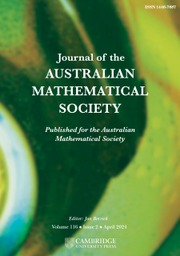Article contents
USING IDEALS TO PROVIDE A UNIFIED APPROACH TO UNIQUELY CLEAN RINGS
Published online by Cambridge University Press: 01 April 2014
Abstract
In this article, we introduce the notion of the uniquely  $I$-clean ring and show that, if
$I$-clean ring and show that, if  $R$ is a ring and
$R$ is a ring and  $I$ is an ideal of
$I$ is an ideal of  $R$ then
$R$ then  $R$ is uniquely
$R$ is uniquely  $I$-clean if and only if (
$I$-clean if and only if ( $R/ I$ is Boolean and idempotents lift uniquely modulo
$R/ I$ is Boolean and idempotents lift uniquely modulo  $I$) if and only if (for each
$I$) if and only if (for each  $a\in R$ there exists a central idempotent
$a\in R$ there exists a central idempotent  $e\in R$ such that
$e\in R$ such that  $e- a\in I$ and
$e- a\in I$ and  $I$ is idempotent-free). We examine when ideal extension is uniquely clean relative to an ideal. Also we obtain conditions on a ring
$I$ is idempotent-free). We examine when ideal extension is uniquely clean relative to an ideal. Also we obtain conditions on a ring  $R$ and an ideal
$R$ and an ideal  $I$ of
$I$ of  $R$ under which uniquely
$R$ under which uniquely  $I$-clean rings coincide with uniquely clean rings. Further we prove that a ring
$I$-clean rings coincide with uniquely clean rings. Further we prove that a ring  $R$ is uniquely nil-clean if and only if (
$R$ is uniquely nil-clean if and only if ( $N(R)$ is an ideal of
$N(R)$ is an ideal of  $R$ and
$R$ and  $R$ is uniquely
$R$ is uniquely  $N(R)$-clean) if and only if
$N(R)$-clean) if and only if  $R$ is both uniquely clean and nil-clean if and only if (
$R$ is both uniquely clean and nil-clean if and only if ( $R$ is an abelian exchange ring with
$R$ is an abelian exchange ring with  $J(R)$ nil and every quasiregular element is uniquely clean). We also show that
$J(R)$ nil and every quasiregular element is uniquely clean). We also show that  $R$ is a uniquely clean ring such that every prime ideal of
$R$ is a uniquely clean ring such that every prime ideal of  $R$ is maximal if and only if
$R$ is maximal if and only if  $R$ is uniquely nil-clean ring and
$R$ is uniquely nil-clean ring and  $N(R)= {\mathrm{Nil} }_{\ast } (R)$.
$N(R)= {\mathrm{Nil} }_{\ast } (R)$.
Information
- Type
- Research Article
- Information
- Copyright
- Copyright ©2013 Australian Mathematical Publishing Association Inc.
References
- 1
- Cited by

